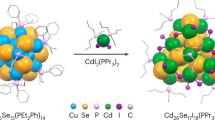Abstract
Nanoparticles under a few nanometres in size have structures and material functions that differ from the bulk because of their distinct geometrical shapes and strong quantum confinement. These qualities could lead to unique device applications. Our mass spectral analysis of CdSe nanoparticles reveals that (CdSe)33 and (CdSe)34 are extremely stable: with a simple solution method, they grow in preference to any other chemical compositions to produce macroscopic quantities. First-principles calculations predict that these are puckered (CdSe)28-cages, with four- and six-membered rings based on the highly symmetric octahedral analogues of fullerenes, accommodating either (CdSe)5 or (CdSe)6 inside to form a three-dimensional network with essentially heteropolar sp3-bonding. This is in accordance with our X-ray and optical analyses. We have found similar mass spectra and atomic structures in CdS, CdTe, ZnS and ZnSe, demonstrating that mass-specified and macroscopically produced nanoparticles, which have been practically limited so far to elemental carbon1, can now be extended to a vast variety of compound systems.
This is a preview of subscription content, access via your institution
Access options
Subscribe to this journal
Receive 12 print issues and online access
$259.00 per year
only $21.58 per issue
Buy this article
- Purchase on Springer Link
- Instant access to full article PDF
Prices may be subject to local taxes which are calculated during checkout





Similar content being viewed by others
References
Kraetschmer, W., Lamb, L.D., Fostiropoulos, K. & Huffman, D.R. Solid C60: A new form of carbon. Nature 347, 27–30 (1990).
Kumar, V. & Kawazoe, Y. Metal-encapsulated fullerene like and cubic caged clusters of silicon. Phys. Rev. Lett. 87, 045503 (2001).
Seifert, G., Fowler, P.W., Mitchell, D., Porezag, D. & Frauenheim, Th. Boron-nitrogen analogues of the fullerenes: Electronic and structural properties. Chem. Phys. Lett. 268, 352–358 (1997).
Stephan, O. et al. Formation of small single-layer and nested BN cages under electron irradiation of nanotubes and bulk material. Appl. Phys. A 67, 107–111 (1998).
Murray, C.B., Norris, D.J. & Bawendi, M.G. Synthesis and characterization of nearly monodisperse CdE (E = S, Se, Te) semiconductor nanocrystallites. J. Am. Chem. Soc. 115, 8706–8715 (1993).
Ptatschek V. et al. Quantized aggregation phenomena in II–VI semiconductor colloids. Ber. Bunsenges. Phys. Chem. 102, 85–95 (1998).
Peng, X. et al. Shape control of CdSe nanocrystals. Nature 404, 59–61 (2000).
Martin, T.P. Shells of atoms. Phys. Rep. 273, 199–241 (1996).
Pinto, A. et al. Evidence for truncated octahedral clusters in supported gold clusters. Phys. Rev. B 51, 5315–5321 (1995).
Kresse, G. & Furthmuller, J. Efficient iterative schemes for ab-initio total energy calculations using a plane-wave basis set. Phys. Rev. B 55, 11169–11186 (1996).
Acknowledgements
The authors are indebted to M.Tachiki, Y.Nishina, K.Suzuki, A.Inoue, K.Sumiyama, T.Ohsuna and J. R. Anderson for discussions and comments.
Author information
Authors and Affiliations
Corresponding author
Ethics declarations
Competing interests
The authors declare no competing financial interests.
Rights and permissions
About this article
Cite this article
Kasuya, A., Sivamohan, R., Barnakov, Y. et al. Ultra-stable nanoparticles of CdSe revealed from mass spectrometry. Nature Mater 3, 99–102 (2004). https://doi.org/10.1038/nmat1056
Received:
Accepted:
Published:
Issue Date:
DOI: https://doi.org/10.1038/nmat1056
This article is cited by
-
Investigation of thermoelectric properties of cadmium selenide CdnSen (n= 7, 11, 13) molecular junctions: a DFT study
Journal of Molecular Modeling (2024)
-
The precursor compound of two types of ZnSe magic-sized clusters
Nano Research (2022)
-
Properties at the interface of the pristine CdSe and core–shell CdSe-ZnS quantum dots with ultrathin monolayers of two-dimensional MX2 (M: Mo, W; X: S, Se, Te) heterostructures from density functional theory
Journal of Molecular Modeling (2022)
-
Size matters: Steric hindrance of precursor molecules controlling the evolution of CdSe magic-size clusters and quantum dots
Nano Research (2022)
-
GaAs quantum dot/TiO2 heterojunction for visible-light photocatalytic hydrogen evolution: promotion of oxygen vacancy
Advanced Composites and Hybrid Materials (2022)



